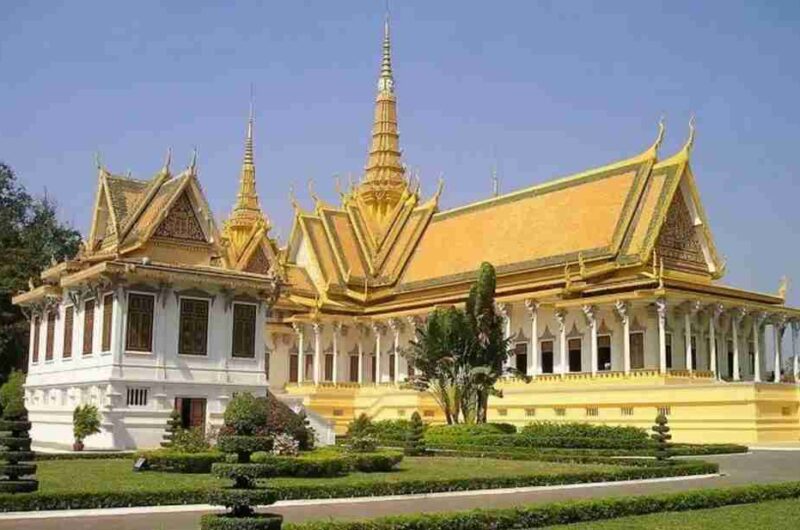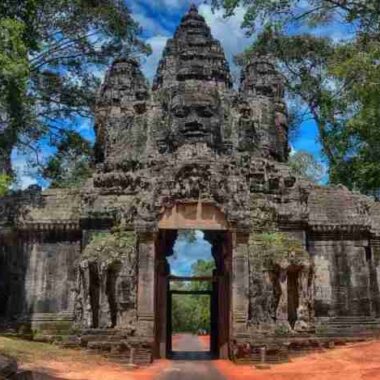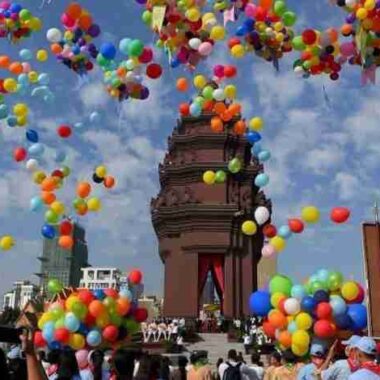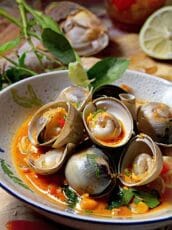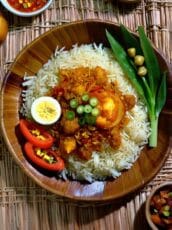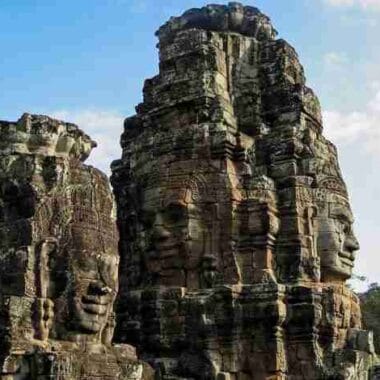The Royal Palace in Phnom Penh is a complex of buildings which servers as home to Cambodia’s official royal residence. The Kings of Cambodia have occupied it since it was built in the 1860s. There is a period of absence period of the Royal family when the country came into turmoil during and after the reign of the Khmer Rouge. The palace was constructed between 1866 and 1870, after King Norodom relocated the royal capital from Oudong to Phnom Penh. It is situated at the Western bank of the cross division of the Tonle Sap River and the Mekong River called Chaktomuk.
History of the Royal Palace in Cambodia
The construction of the Royal Palace at Phnom Penh is a recent event in the history of the Cambodia. During 802 AD until the early 15th century, the Khmer power located in the region near Angkor noth of the Great Tonle Sap Lake. In 1434 the Khmer court moved from Angkor and settled in Phnom Penh and stayed for some decades, but by 1494 had moved on to Basan, and later Lovek and then Oudong. The capital did not return to Phnom Penh until the 19th century. In 1813, King Ang Chan constructed Bantey Kev (the Cristal Citadel) on the current location of the Royal Palace and stayed briefly before moving to Oudong Capital. It was not until after the implementation of the French Protectorate in Cambodia in 1863 that the capital was moved from Oudong to Phnom Penh, and the current Royal Palace was founded and constructed.
Exploring the Royal Palace
Large parts of the sprawling grounds and formal gardens are open to the public, only the Throne Hall and a clutch of buildings surrounding it are opened for visitor. It still remains the official royal residence, so the areas devoted to royal living are closed to visitors. There are several entrances to the palace, however the visitor only allowed to enter from The southern gate where the entrance ticket was sold.
The tourist code when visiting the Royal Palace
- The Royal Palace open for public visit daily from 7-11am and 2-5pm, except in especial state events.
- The entrance fee of $10 USD covers the cost of accessing the Silver Pagoda as they are located on the same compound.
- There are guides available to hire, this may be worthwhile, particularly when it comes to the Silver Pagoda treasure and its history.
- The dress code for the Royal Palace of Phnom Penh requires visitors dress respectfully and modestly as the Royal Palace is the home of the King. The visitors must have shoulders and upper arms covered, and shorts or skirts need to extend to the knees.
- Apparently, you can purchase sarongs at the entrance to the Royal Palace if you’re inappropriately dressed. Another option is to carry your own light weight shawl with you. The Royal Palace Phnom Penh Dress code seems to be fully enforced, so be prepared.
- Do not wear hats was allowed on the Palace grounds.
- Photograph are prohibited for some areas.
The Royal Palace buildings
The Royal Palace contains some spectacular buildings such as Moonlight Pavilion, Throne Hall, Silver Pagoda, Khemarin Palace. Other structures include, Hor Samran Phirun, Hor Samrith Phimean, Damnak Chan, Phochani Pavilion (dance hall), Serey Monkol Pavilion (royal conference hall), King Jayavarman VII Pavilion, Vihear Suor (royal chapel), Villa Kantha Bopha, Villa Chumpou, Villa Sahametrei, and some less significant buildings in an area closed to the public.

The Throne Hall
In Khmer, Throne Hall is called Preah Thineang Vinnichay, is the primary audience hall of the King, used for coronations and diplomatic and other official meetings. The first was constructed of wood in 1869-1870 under King Norodom. That Throne Hall was demolished in 1915. The present building was constructed in 1917 and inaugurated by King Sisowath in 1919. The building is 30×60 meters and topped by a 59-meter spire. The Thrown Hall is one of the best attractions inside the Royal Palace Phnom Penh.
The Silver Pagoda
The Silver Pagoda is located on the south side of the Royal Palace, as known as Wat Preah Keo Morakot which is commonly shortened to Wat Preah Keo in Khmer. The Silver Pagoda is so named for its floor, which is covered with 5 tons of gleaming silver. You can sneak a peek at some of the 5000 tiles near the entrance, but most are covered for protection. Inside is a series of lavish Buddha statues made of precious metals. The staircase leading to the Silver Pagoda is made of Italian marble.
The vihara houses many national treasures including many gold and jeweled Buddha statues. The most significant are a small green crystal Buddha, and a life-sized gold Maitreya Buddha commissioned by King Sisowath, weighing 90 kg and dressed in royal regalia and set with 9584 diamonds, the largest of which weighing 25 carats, created in the palace workshops during 1906 and 1907. Directly in front of it, in a Formica case, is a miniature silver-and-gold stupa containing a relic of Buddha brought from Sri Lanka.
The pagoda was originally constructed of wood in 1892 during the rule of King Norodom and was rebuilt in 1962. Although more than half of the pagoda’s contents were lost, stolen or destroyed in the turmoil that followed the Vietnamese invasion, what remains is spectacular. This is one of the few places in Cambodia where bejeweled objects embodying some of the brilliance and richness of Khmer civilization can still be seen.
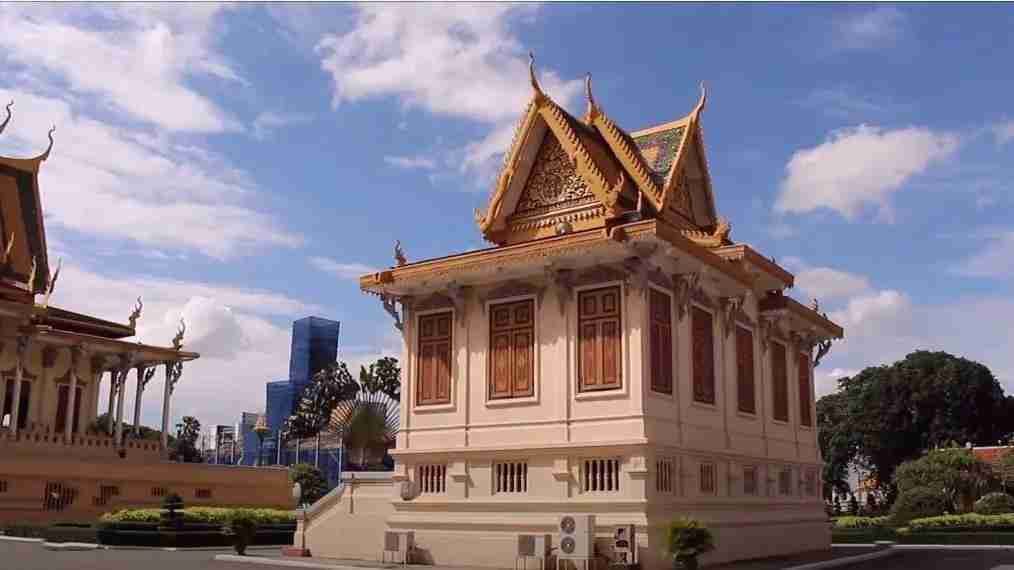
The Chanchhaya Pavilion known as Moonlight Pavilion
“The Preah Thineang Chan Chhaya or “Moonlight Pavilion”, is an open-air pavilion that serves as stage for Khmer classical dance in the past and present. It is one of the most notable buildings of the palace as it easily seen from the outside as it was built alongside a section of the palace walls. The Chan Chhaya Pavilion has a balcony that was used as a platform for viewing parades marching along Sothearos Boulevard of Phnom Penh.
The Moonlight Pavilion constructed in 1913-14 under King Sisowath to replace the earlier wooden pavilion built under King Norodom. The current pavilion is of the same design as the earlier version. The Pavilion serves as a venue for the Royal Dancers, as a tribune for the King to address the crowds and as a place to hold state and Royal banquets. Most recently, the Pavilion was used for a banquet and a tribune for the new King at the 2004 coronation of King Norodom Sihamoni.
The Napoleon III Pavilion
At first glance the Napoleon III Pavilion seems almost out-of-place, sitting like a European-style dollhouse amongst the imposing and distinctly Khmer-style buildings that surround it. Given to King Norodom by Napoleon III of France in 1876, it was hardly designed with the Cambodian climate in mind. In fact, it was originally built for the inauguration of the Suez Canal in 1869, before being shipped to Cambodia in pieces. The Pavilion was refurbished in 1991 with financial assistance from the French government. The Pavilion now serves as a small museum housing Royal memorabilia and a photographic exhibition.
The Khemarin Palace
The Khemarin Palace known in Khmer as Khemarin Moha Prasat, it is used as an official residence of the King of Cambodia. This compound is separated from other buildings by a small wall and is located to the right of the Throne Hall. The main building is topped with a single spired prang. Khemarin Palace The Royal residence. Closed to the public.
The Hor Samran Phirun
Hor Samran Phirun means The pavilion where one sleeps peacefully. Itis a Royal family rest house and waiting area where the King waits to mount an elephant for Royal processions. Also It was built to house musical instruments and procession implements. The Hor Samran Phirun Constructed in 1917. Currently it is used for housing a display of gifts from foreign heads of state.
Hor Samrith Phimean
Hor Samrith Phimean Also know as the ‘Bronze Palace.’ Repository for the Royal regalia and attributes. It was Constructed in 1917 and currently it is used for housing a display of royal regalia and costumes on the ground floor.
The Damnak Chan
The Damnak Chan currently houses the administrative offices of the Royal Palace. It was original constructed in 1953 for the High Council of the Throne, this building has served several purposes over the years. Damnak Chan is only a building in the Royal Palace which have mix of Khmer and Western architectural styles, sporting a distinctly Khmer-style roof and a Western style in the main body of the building. It is closed to the public.
The Phochani Pavilion (dance hall)
Phochani Pavilion is an open hall originally constructed as a classical dance theater and it was build in 1912. It is currently used for Royal receptions and meetings.
The Serey Monkol Pavilion (royal conference hall)
Serey Monkol Pavilion is originally constructed as Royal conference hall and this building has served several purposes over the years.
